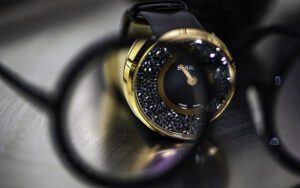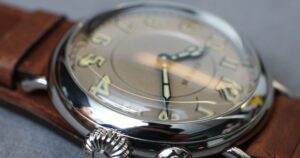Whether your watch is standard, luxury, or vintage, you might want to protect it from damage. Everyone’s idea of “damage” is different—many watch owners, especially vintage watch collectors, find minor scratches to be desirable in telling the watch’s story. But if you’re a purist and want to keep your watch looking pristine, or you just want to avoid significant damage, there are several things you can do to protect your watch.

Table of Contents
Toggle1. Check Your Watch’s Water-Resistance Level
If moisture gets inside your watch, the parts can become rusty or corroded, causing a domino effect of damage. Most watches come with some water resistance to avoid everyday moisture, like from handwashing. Some watches, like diver’s watches, are tightly sealed and can handle being fully submerged.
Before wearing your watch to any occasion where there’s a chance of it getting wet—maybe you’ll be attending a beachside wedding or a party with drinking and dancing—make sure you know its level of water resistance. If being splashed could compromise your watch, leave it at home and choose a hardier model.
2. Remove Your Watch Temporarily
Many times, you’ll want to wear a particular watch for the day, but you’ll be doing activities that aren’t good for a watch.
For instance, if you’re going to be playing a sport (or doing any fairly strenuous activity), you should remove your watch. The possibility of knocking your watch and damaging the movement is just too great a risk. Additionally, any sweat from your wrist that gets inside the sealings could cause slow but catastrophic damage.
Here’s one you might not have thought of: if you’re applying makeup or hair products, make sure your watch is off your wrist and in another room. These substances can leave a residue on the watch or get inside the watch case, causing the gears to seize up.
3. Store Your Watch Correctly
For all occasions when you’re not wearing your watch, you should be storing your watch in a watch box or safe. It should have a soft interior and a securely closing exterior, and your watch should fit perfectly without any room for it to get jostled around.
If you’re only taking your watch off for a few minutes, never place it on its crystal or crown. The crystal can be scratched easily, and the stress from putting it on its crown will damage the watch’s movement. Only place it face-up and in a secure location.
4. Don’t Pair Your Watch with Bracelets
This might seem like a smart fashion statement, but wearing bracelets on the same wrist as your watch is actually a major faux pas in the watch world. Bracelets can scratch your watch’s case, crown, straps, and crystal.
While many vintage watch collectors find scratches to be a positive trait, it’s not a great idea to intentionally put your watch in harm’s way every time you wear it. If you must wear bracelets, put them on your other wrist.
5. Wear Your Watch on Your Non-Dominant Wrist
Speaking of the correct wrist for your watch, you should wear it on your non-dominant wrist. If you don’t know why, this might seem like an unwritten rule. The real reason is because your watch is much less likely to be knocked or scratched when worn this way. Even the slightest hit to your watch can damage the delicate inner pieces, so it’s best to minimize any chance of it being knocked.
6. Be Careful with Polishing
Polishing your watch seems like a reasonably safe thing, but polishing it improperly can do much more harm than good. If you use the wrong material to polish your watch or go even just a little overboard, you can round out sharp corners or remove many of the watch’s distinctive characteristics.
If you must polish your watch yourself, do your research to make sure you’re using the right material for your specific watch—for example, a brushed surface will require a different approach than a high-polished surface. If you want a good polish but don’t trust yourself to do it, leave it in the hands of an experienced watchmaker.
7. Only Use Certified Watchmakers for Repairs
Many watch owners think that simply opening and closing a watch—maybe for a battery change or a quick cleaning—is no big deal. But every time a watch owner does this, they risk damage to the watch’s case, movement, and sealings if a repair isn’t done properly.
Whether you’re looking for Omega, Cartier, or Patek watch repair, this service requires years of intensive training. It’s only a job for a certified watchmaker. Anyone who doesn’t know what they’re doing when attempting a watch repair risks catastrophic damage to the delicate inner workings of a watch.
Bonus: Ask Your Watchmaker for Replacement Parts
If you want to go the extra mile in protecting your watch from breaks and scratches, you can ask your watchmaker to replace some of its parts. Replacing your bezel with a ceramic bezel will make it more scratch-resistant. You can also ask for the crystal to be swapped for a sapphire crystal. Sapphire crystals are the strongest and most scratch-resistant crystals available, so you should get a lot of life from one.
If you own a vintage watch and you’re interested in getting some parts replaced for protection, you should know that replacing vintage parts will lower the value of the watch. This shouldn’t be a problem if you’re not planning to resell it. However, if you think there’s a chance you’ll resell it one day, it’s best just to accept that your watch will get scratched and maybe dented. This isn’t necessarily a bad thing—every scratch adds character to your vintage watch.
Video
Infographic
Protect your standard, luxury, or vintage watch from damage. You can keep your watch looking great and avoid significant damage. Find out how to protect your watch in this infographic.






